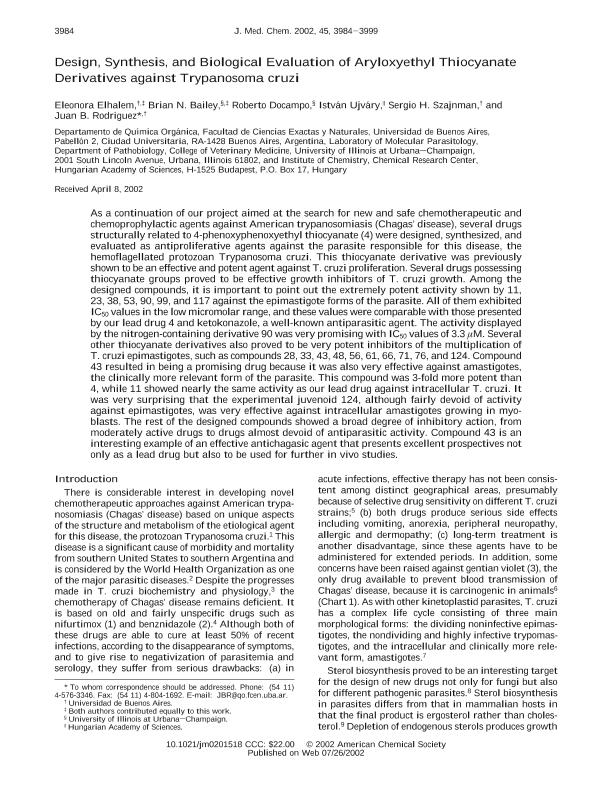Artículo
Design, synthesis, and biological evaluation of aryloxyethyl thiocyanate derivatives against Trypanosoma cruzi
Elhalem, Eleonora ; Bailey, Brian N.; Docampo, Roberto; Ujváry, István; Szajnman, Sergio Hernan
; Bailey, Brian N.; Docampo, Roberto; Ujváry, István; Szajnman, Sergio Hernan ; Rodriguez, Juan Bautista
; Rodriguez, Juan Bautista
 ; Bailey, Brian N.; Docampo, Roberto; Ujváry, István; Szajnman, Sergio Hernan
; Bailey, Brian N.; Docampo, Roberto; Ujváry, István; Szajnman, Sergio Hernan ; Rodriguez, Juan Bautista
; Rodriguez, Juan Bautista
Fecha de publicación:
08/2002
Editorial:
American Chemical Society
Revista:
Journal of Medicinal Chemistry
ISSN:
0022-2623
Idioma:
Inglés
Tipo de recurso:
Artículo publicado
Clasificación temática:
Resumen
As a continuation of our project aimed at the search for new and safe chemotherapeutic and chemoprophylactic agents against American trypanosomiasis (Chagas' disease), several drugs structurally related to 4-phenoxyphenoxyethyl thiocyanate (4) were designed, synthesized, and evaluated as antiproliferative agents against the parasite responsible for this disease, the hemoflagellated protozoan Trypanosoma cruzi. This thiocyanate derivative was previously shown to be an effective and potent agent against T. cruzi proliferation. Several drugs possessing thiocyanate groups proved to be effective growth inhibitors of T. cruzi growth. Among the designed compounds, it is important to point out the extremely potent activity shown by 11, 23, 38, 53, 90, 99, and 117 against the epimastigote forms of the parasite. All of them exhibited IC50 values in the low micromolar range, and these values were comparable with those presented by our lead drug 4 and ketokonazole, a well-known antiparasitic agent. The activity displayed by the nitrogen-containing derivative 90 was very promising with IC50 values of 3.3 μM. Several other thiocyanate derivatives also proved to be very potent inhibitors of the multiplication of T. cruzi epimastigotes, such as compounds 28, 33, 43, 48, 56, 61, 66, 71, 76, and 124. Compound 43 resulted in being a promising drug because it was also very effective against amastigotes, the clinically more relevant form of the parasite. This compound was 3-fold more potent than 4, while 11 showed nearly the same activity as our lead drug against intracellular T. cruzi. It was very surprising that the experimental juvenoid 124, although fairly devoid of activity against epimastigotes, was very effective against intracellular amastigotes growing in myoblasts. The rest of the designed compounds showed a broad degree of inhibitory action, from moderately active drugs to drugs almost devoid of antiparasitic activity. Compound 43 is an interesting example of an effective antichagasic agent that presents excellent prospectives not only as a lead drug but also to be used for further in vivo studies.
Palabras clave:
thiocyanate
,
chagas
,
Trypanosoma cruzi
,
synthesis
Archivos asociados
Licencia
Identificadores
Colecciones
Articulos(UMYMFOR)
Articulos de UNID.MICROANAL.Y MET.FISICOS EN QUIM.ORG.(I)
Articulos de UNID.MICROANAL.Y MET.FISICOS EN QUIM.ORG.(I)
Citación
Elhalem, Eleonora; Bailey, Brian N.; Docampo, Roberto; Ujváry, István; Szajnman, Sergio Hernan; et al.; Design, synthesis, and biological evaluation of aryloxyethyl thiocyanate derivatives against Trypanosoma cruzi; American Chemical Society; Journal of Medicinal Chemistry; 45; 18; 8-2002; 3984-3999
Compartir
Altmétricas



